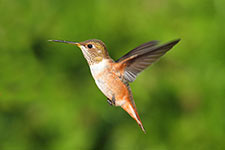
Rufous Hummingbird
Posted by Grange Co-op on 2nd Oct 2013
Male: Mainly orange-brown all over (looks like a shiny copper penny) with a dark gorget that reflects iridescent orange-red in sunlight and white collar. Wings may be green.
Female: Green back and crown, orange-brown sides and tail, white belly and throat with iridescent reddish throat dots.
 Nesting:
Nesting:
Female builds a soft, flexible cup nest that expands to accommodate the growing young. The nest is made of downy plant fibers and moss, covered with lichens and held together with spider’s silk. It is placed on a downward-sloping limb of a tree or shrub, well hidden. The female incubates 2 white eggs for about two weeks. Young fledge 21 days later.
Feeding:
The Rufous darts and hovers to catch insects and sip flower nectar. Also eats spiders, sap and insects trapped in the sap from holes drilled by sapsuckers. Readily visits hummingbird feeders.
Habitat:
Summer breeding resident in woods edges, thickets, parks, gardens and mountain meadows. The Rufous has the longest migration route of any N. American hummingbird, spending the winters in Central and South America and summers as far north as southern Alaska. The southern boundary of its breeding range lies in Oregon.
OTHER INTERESTING FACTS:
The Rufous is the most aggressive of all hummers, readily displacing Anna’s, Broad-tailed, Calliope, and Black-chinned Hummingbirds from flower areas. It is one of the smallest birds in the state, weighing just 2 - 3 gm. Its heart pumps an incredible 1260 beats per minute. Males perform a spectacular pendulum-like flight over a perched female. After mating, the female flies off to build a nest and raise young, without any help from her mate. The hummingbird doesn’t sing, but will chatter or buzz to communicate.
COMPARE TO:
Allen’s Hummingbird has a green back with rufous sides. The female and immature Allen’s are often indistinguishable from the Rufous in the field. The Allen’s has a very small territory in Oregon, along the southern-most coast, rarely coming inland.
Would you like to attract birds to your yard? We’ve got a great selection of products to help you and your feathered friends get together. Shop our Wild Bird department now.
